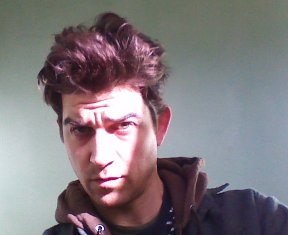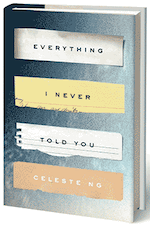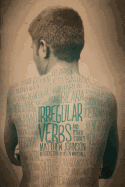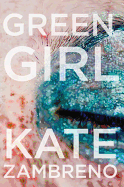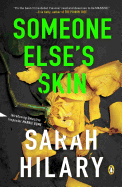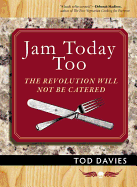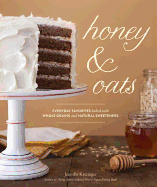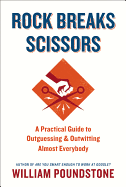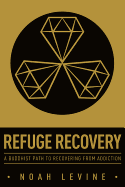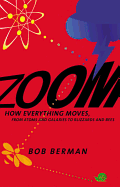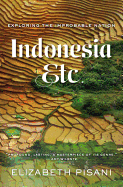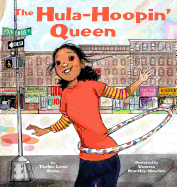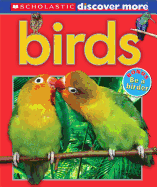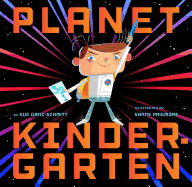 |
| Kevin Day Photography |
Celeste Ng grew up in Pittsburgh, Pa., and Shaker Heights, Ohio, in a family of scientists. She attended Harvard University and earned an MFA from the University of Michigan (now the Helen Zell Writers' Program at the University of Michigan), where she won the Hopwood Award. Her fiction and essays have appeared in One Story, TriQuarterly, Bellevue Literary Review, Kenyon Review Online and elsewhere, and she is the recipient of the Pushcart Prize. She lives in Cambridge, Mass., with her husband and son.
Tell us about the inspiration for Everything I Never Told You.
Long ago, my husband told me about a school friend who'd pushed his own younger sister into a lake. She was okay, but I couldn't get that picture of a young girl, underwater, out of my head. I started thinking about family dynamics and jealousy--and, of course, I wondered what it would have been like to be that girl. As a writer does, I started to tweak the situation. What if the girl had drowned? What if she had been the family favorite? The novel evolved to be quite different from the original story, but that image--a girl falling into water--was the seed.
You've published short stories and essays previously. How is writing a novel different?
The short story is so elegant and taut and self-contained; it's like a little pearl, rounded and satiny and seamless. The novel is a bigger, baggier thing, like a giant tapestry, and there are always parts that are less tightly woven, where the snags or loose ends show. But there's also more scope to explore, more space for risks and nuance.
One of my professors at Michigan, Nancy Reisman, told us she knew she was writing a novel when she couldn't hold the whole thing in her head at once, and that felt extremely apt to me. In writing short stories, I often have one lightning-flash of clarity where I know how to connect all the parts. But I couldn't "see" the whole novel at once. I had to slowly weave the strands together, draft by draft, with a lot of unraveling and re-weaving along the way.
One of the book's mysteries is whether Lydia's death is foul play, suicide or an accident. How did you decide which it would be, or did you always know?
I did know from the beginning what had happened to Lydia, though I had to write the rest of the novel to truly understand her history, her family's history, and how things came to this point. The bigger process was finding the best way to tell the story. In early drafts, I didn't even reveal that Lydia was dead until a few chapters in, and other information that helps you piece together what happened wasn't revealed until much later. I had to trust the story and the reader, and make the main question of the book not "Where is Lydia?" but "How did this happen to her?"
Does being a parent make writing about someone losing a child emotionally difficult?
It absolutely does. When I started the novel, I wasn't yet a parent, but after my son was born--between the third and final drafts--revisiting the scenes of loss, especially the ones from Marilyn's and James's perspectives, became incredibly difficult on a visceral level. Sometimes I'd stay up late writing and then need to sneak into my son's room to hold him while he was sleeping.
I often wonder why I was drawn to write something that terrifies me so much. Actually, I often find myself imagining in great detail the things that scare me most--like, if I think my way through them, I'll be less frightened by them. (As if you could practice devastation enough for it to lose its power.) Like many writers, I write about terrifying things as a way of... well, if not taming, at least grappling with those fears.
Did you find growing up Asian-American to have its drawbacks, or were you in a community that accepted diversity?
Growing up anything probably has its drawbacks. I grew up in areas with virtually no other Asians--outside Pittsburgh, then outside Cleveland. In my first elementary school, I was the only Asian (and one of two non-whites). Teachers always hesitated during roll when they got to my last name. And you can spot me instantly in every class photo. It can be very bizarre to be visibly different from everyone around you, as my husband learned when we visited Hong Kong and he, a tall white guy, was surrounded by Asians.
My family celebrated Chinese holidays and ate Chinese food, but we also went to Wendy's (my dad's favorite), watched Disney movies and had cookouts on July 4th. Straddling two cultures is strange. I was often acutely conscious of being Chinese--but when I went to San Francisco or Hong Kong, I was acutely conscious of how un-Chinese I was. That's partly why I'm interested in writing about outsiders. I drew on that for Everything I Never Told You--all the characters feel they don't belong in some way.
The Lee family is torn apart by everyday secrets about their inner selves kept from one another. Why do people hide their thoughts and dreams even from their loved ones?
I constantly ask myself that. That's one reason I started writing the novel: to explore how well we ever really know others, even the ones we love most.
I read this fascinating article on pointing (bear with me; I swear this is relevant)--scientists were thrilled to learn that elephants understand pointing, because besides humans, almost no other animals get it. It turns out pointing is really complicated: you have to understand that you have thoughts, that others don't know those thoughts, and that you can share those thoughts with others. When you think about it that way, all communication starts to feel like a giant game of telephone: Can you ever be certain the other person understands exactly what you mean? All we have to transmit everything in our minds is language--and at times, language can feel really inadequate, like trying to funnel the ocean through a straw. It's kind of amazing that we're ever able to share even the most basic information, let alone our most complicated dreams and fears.
In that sense, sharing a thought with another person is a leap of faith: you have to trust that they'll hear what you're saying. The bigger the dream or the more pressing the fear, the higher the stakes. Maybe that fear is what makes us hide things from those we love: trying to say something, and having them (of all people) not understand, can be more painful than staying silent. --Jaclyn Fulwood
Celeste Ng: Everyday Secrets
